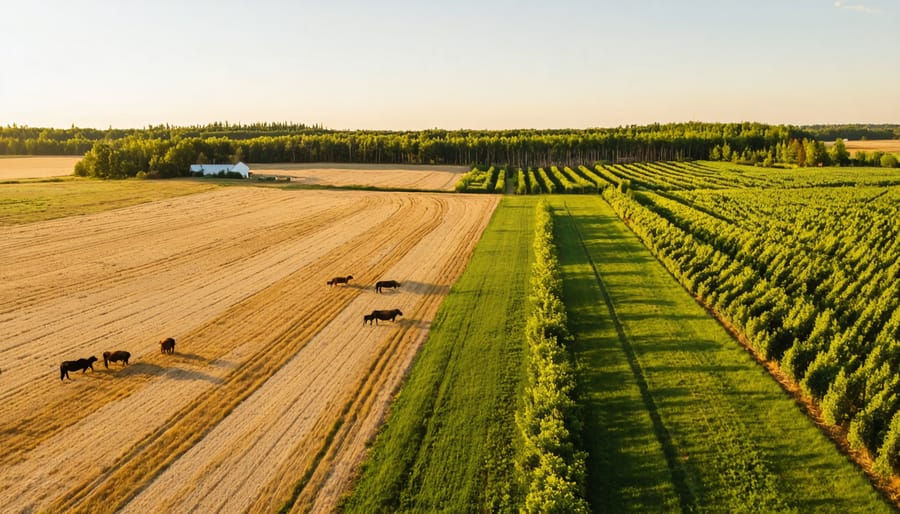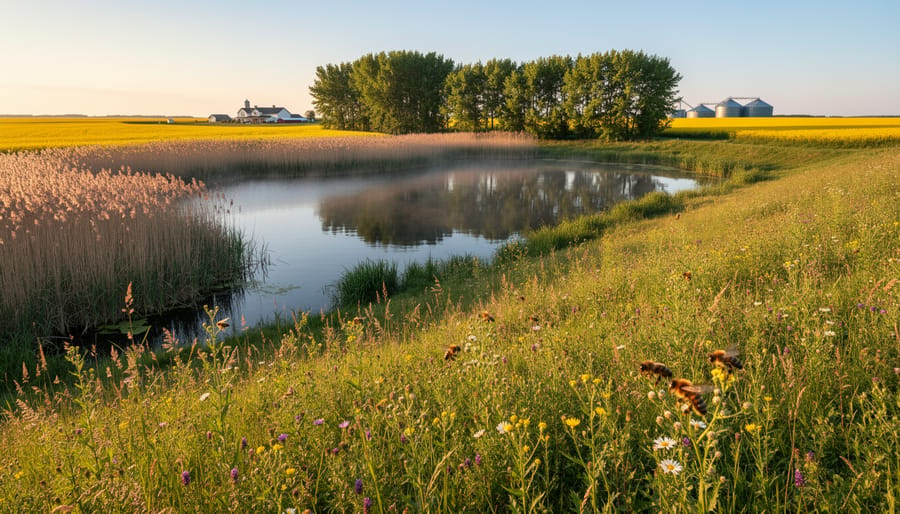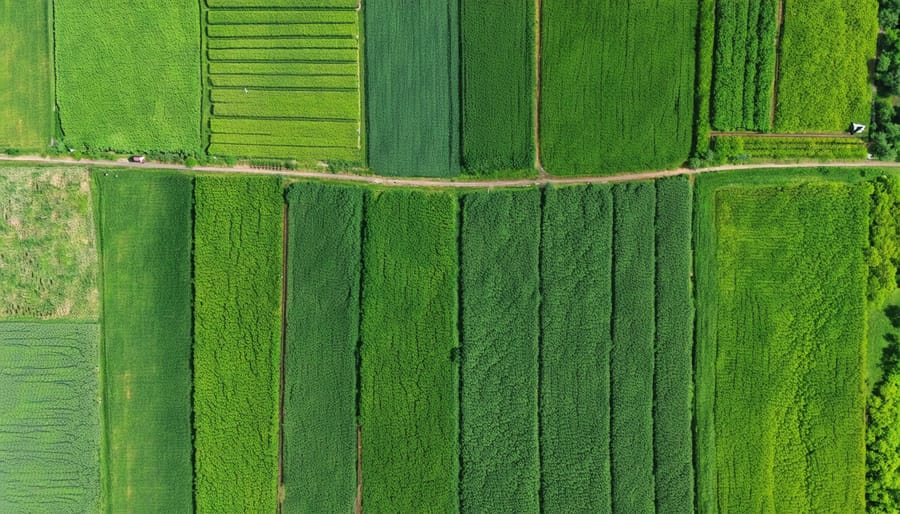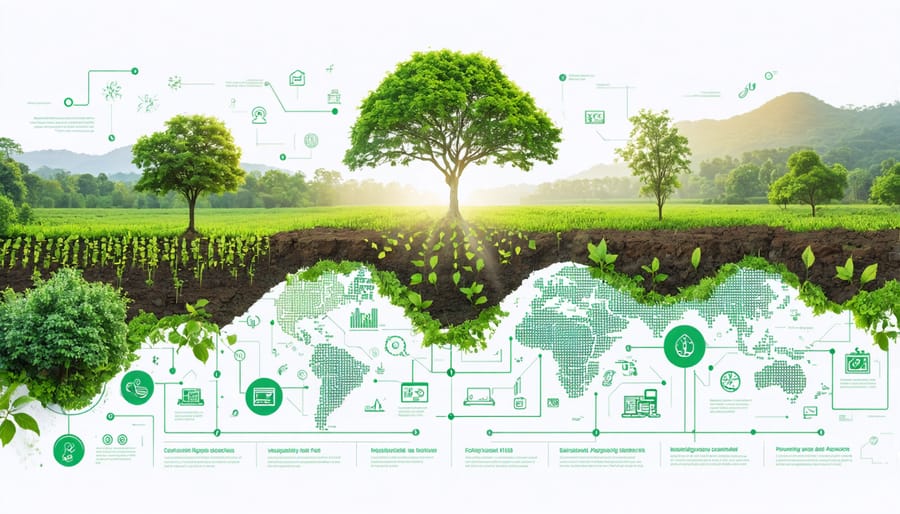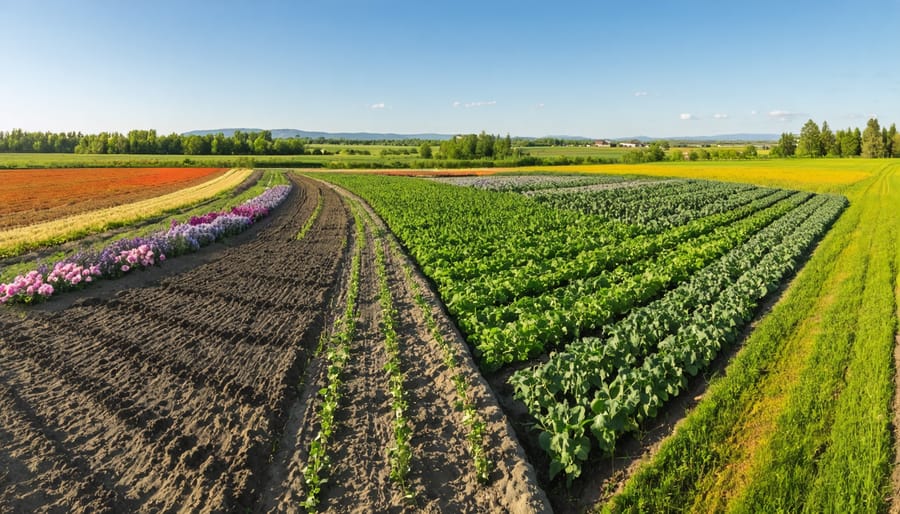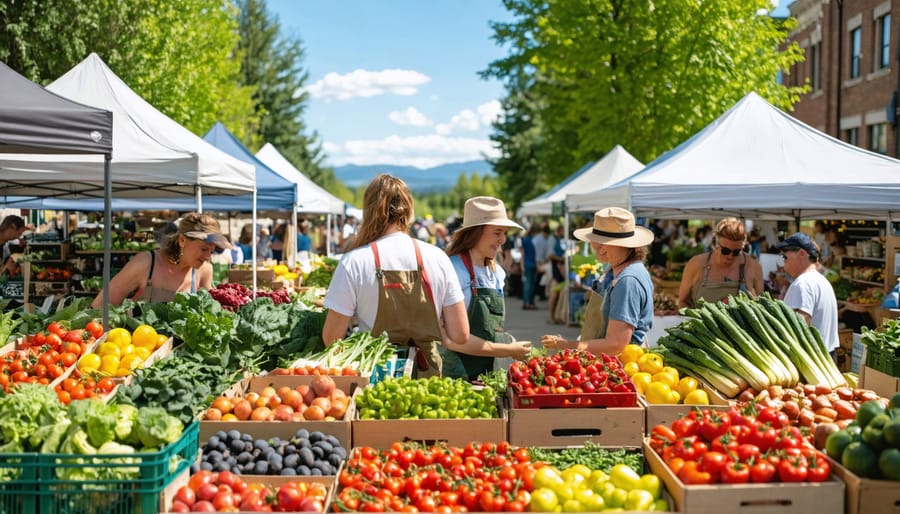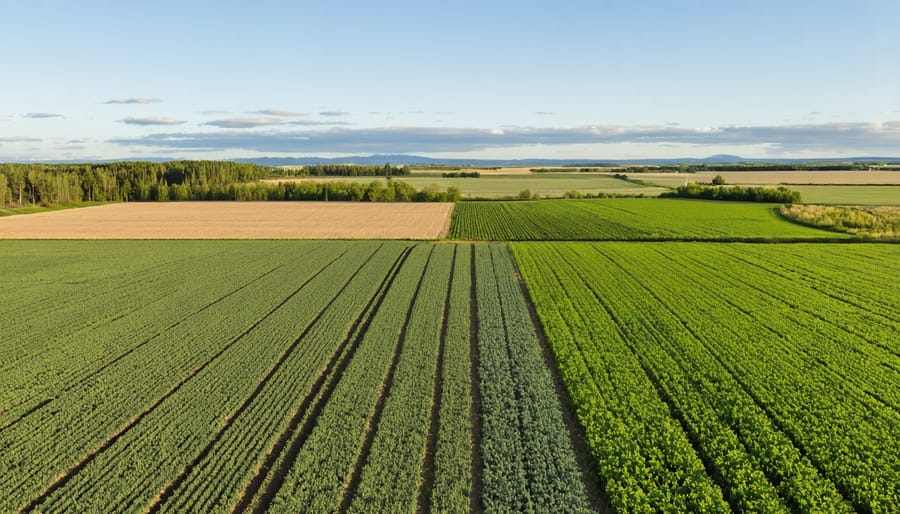Diversify your income streams by integrating tree crops with annual production—a strategy tropical farmers have used for decades to weather price volatility and climate uncertainty. When coffee prices crashed in the 1990s, Central American producers with timber, fruit, and cacao integrated into their systems maintained profitability while monoculture operations failed. This same principle of economic buffering through vertical layering applies directly to Canadian operations, where incorporating hazelnut rows between grain fields or establishing managed woodlots alongside pasture creates multiple revenue timelines that protect against single-market collapse.
The financial logic transcends geography: stacking productive layers means stacking income opportunities. A hectare generating revenue from three different products at different harvest intervals provides steadier cash flow than the same area dependent on one annual crop. Saskatchewan grain farmers are already proving this by adding silvopasture systems that generate cattle revenue while timber matures, creating immediate returns alongside long-term equity growth. Alberta producers are experimenting with cold-hardy fruit and nut species between shelterbelts, transforming windbreaks from cost centers into productive assets.
The adaptation challenge isn’t replicating tropical species—it’s adopting the economic framework of diversified vertical production. Cold-climate agroforestry substitutes coffee for saskatoons, cacao for hazelnuts, and tropical timber for hybrid poplar, but the underlying financial architecture remains identical: reduce risk through product diversity, maximize land productivity through layering, and build resilience through staggered harvest cycles.
This article demonstrates how tropical agroforestry principles translate into practical economic strategies for Canadian operations, featuring producers who’ve successfully implemented these systems and providing specific steps to begin integration on your land.
What Tropical Agroforestry Can Teach Canadian Farmers About Economic Stability
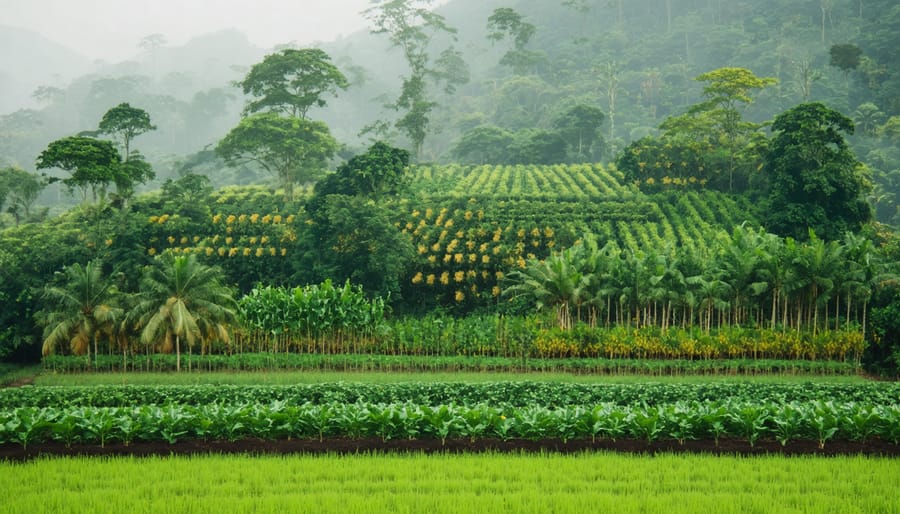
The Multi-Layer Income Strategy
Tropical agroforestry systems thrive financially by harvesting products from multiple layers within the same space—tall timber trees, mid-level fruit producers, shade-loving crops at ground level, and even root crops below the surface. This vertical income stacking creates consistent cash flow throughout the year, buffering farmers against single-crop market fluctuations.
While Canadian winters obviously prevent year-round tropical-style layering, the underlying principle translates remarkably well. Manitoba farmer James Kowalski applies this concept through seasonal diversification on his 160-hectare operation. His spring begins with early greens under hoop houses, transitions to field vegetables and berries in summer, and finishes with storage crops and value-added preserves through winter months. “Instead of vertical layers, we create temporal layers,” he explains. “Different products mature at different times, so income arrives consistently rather than in one harvest rush.”
This approach mirrors regenerative agriculture practices that integrate livestock rotations with crop production. Alberta ranchers increasingly combine cattle grazing with pulse crops, honey production, and shelterbelts that eventually provide timber value—creating four distinct revenue streams from connected systems.
The key insight from tropical models isn’t copying specific crops, but adopting the strategic mindset: design your operation so multiple income sources mature throughout the calendar year. This reduces financial vulnerability while spreading labour demands more evenly across seasons, making farm operations more economically resilient and personally sustainable for Canadian producers.
Climate Adaptation as Economic Insurance
Tropical agroforestry systems function as economic insurance by spreading risk across multiple income streams and seasons. When coffee prices drop, cocoa or timber sales can sustain farm families. This diversification principle applies equally to Canadian operations, though the crops differ significantly.
Alberta’s weather patterns have become increasingly unpredictable over the past decade. Extended drought periods, unexpected frost events, and extreme precipitation now threaten monoculture operations more than ever. By studying how tropical farmers protect income through layered production systems, Canadian growers gain valuable insights for their own climate adaptation strategies.
Consider the parallel: tropical agroforestry combines canopy trees, mid-level shrubs, and ground crops to maximize land productivity while buffering against weather extremes. Canadian farmers are applying similar thinking by integrating shelterbelts, perennial forages, and diverse annual crops. These systems reduce wind erosion, moderate temperature fluctuations, and improve water retention during dry spells.
The economic logic remains consistent across climates. When one enterprise faces market downturns or weather damage, others compensate. Manitoba grain farmer Sarah Chen combined traditional wheat production with haskap berries and heritage livestock, reducing her income volatility by 40 percent over five years. Alberta ranchers are similarly building resilient futures by diversifying operations.
Climate adaptation through diversity isn’t just environmentally sound—it’s financially prudent insurance against an uncertain future.
Real Revenue: How Integrated Tree Systems Protect Your Bottom Line
Reducing Input Costs Through Natural Systems
One of the most compelling economic advantages of agroforestry systems is their ability to dramatically cut input costs. In tropical systems, deep-rooted trees naturally cycle nutrients from lower soil layers back to the surface, reducing fertilizer needs by up to 40% in established plantations. Leguminous trees like Leucaena and Gliricidia fix atmospheric nitrogen, essentially providing free fertilizer to surrounding crops.
These same principles work in temperate climates. “We’ve seen Saskatchewan farmers using hybrid poplar shelterbelts reduce their nitrogen applications by 15-20% in adjacent crop rows,” explains Dr. Jennifer Walsh, agroforestry specialist at the University of Alberta. The trees’ root systems mine nutrients beyond the reach of annual crops while improving soil structure, meaning those expensive inputs work more efficiently.
Pest management costs also decrease significantly. Diverse agroforestry systems naturally host beneficial insects and birds that control pests. In Costa Rican coffee-timber systems, pest damage dropped by 35% compared to monoculture operations, with corresponding reductions in pesticide expenses. Alberta producer Mark Chen reports similar results: “Our haskap berry yields increased 25% after establishing willow windbreaks. The habitat attracted more pollinators and pest predators, and we cut our spray program in half.”
Water management represents another major saving. Tree canopies reduce evaporation while roots improve soil water retention. During Alberta’s 2021 drought, farms with established shelterbelts used 18% less irrigation water than those without tree systems, translating to direct fuel and equipment savings. These natural systems essentially perform expensive services for free once established.

Creating Premium Market Opportunities
Agroforestry systems unlock remarkable opportunities to capture premium prices and access growing markets that value sustainability. Whether you’re managing a mixed farm in Alberta or exploring diversification options, understanding these value-added pathways can significantly boost your bottom line.
Certification programs represent one of the most accessible routes to premium pricing. Organic certification, while requiring an investment of time and planning, typically commands price premiums of 20-40% across various products. Agroforestry naturally supports organic practices by reducing pest pressure and eliminating the need for synthetic inputs in many cases. Canadian farmers integrating trees with crops or livestock often find organic certification more achievable than those running conventional monocultures.
The carbon credits market offers another revenue stream that directly rewards tree planting and soil carbon sequestration. Alberta farmers participating in carbon offset programs have generated additional income ranging from $15-40 per tonne of CO2 equivalent sequestered. With agroforestry systems storing 2-10 tonnes per hectare annually, this creates meaningful supplemental revenue.
Sustainable and regenerative agriculture labels are gaining traction with consumers willing to pay premium prices. Products carrying these certifications often access specialty markets, direct-to-consumer channels, and export opportunities unavailable to conventional producers.
Dr. Sarah Mitchell from the University of Alberta notes, “We’re seeing Canadian agroforestry operations successfully marketing specialty products like forest-raised pork, shade-grown berries, and sustainably harvested timber products at 30-50% price premiums.”
The key is matching your production system with certifications that align with your management practices and target markets. Start by identifying which premium markets serve your region, then work backward to understand certification requirements and implementation timelines.
Canadian Farmers Already Using These Principles Successfully
Alberta Mixed Farm: Integrating Shelterbelts as Production Assets
When the Vandermeer family in central Alberta looked at their mature shelterbelt system in 2018, they saw more than just windbreaks. They saw untapped revenue potential. Working with agricultural consultants, they transformed 4.8 kilometres of existing shelterbelts into diversified production assets while maintaining their protective function.
The operation started with selective thinning of mature caragana and Colorado spruce planted decades earlier for wind protection. “We were already managing these trees anyway,” explains Dale Vandermeer. “The question became how to make them pay for themselves.” The family introduced 150 haskap berry bushes in the understory of their northern shelterbelt, choosing this hardy species for its -47°C cold tolerance and premium market value.
The results exceeded expectations. Berry production generated $8,200 in direct sales during the third year, while the established shelterbelts continued reducing wind speed by 65 percent across adjacent fields. Canola yields in the protected zone increased by 12 percent compared to exposed areas, adding approximately $14,000 in additional crop revenue across 32 hectares. The shelterbelts also attracted beneficial insects that improved pollination rates in adjacent pulse crops.
Perhaps more importantly, the integrated approach created multiple income streams that smoothed out seasonal cash flow. While grain sales remained the primary revenue source, berry sales provided early-season income during typically lean months. The family now plans to add Saskatoon berry bushes to their southern shelterbelts and is exploring chokecherry production.
The Vandermeers’ experience demonstrates that adapting the diversification principles from tropical agroforestry doesn’t require palm trees or tropical climates. It requires looking at existing farm infrastructure through an economic lens and asking what else those assets can produce.
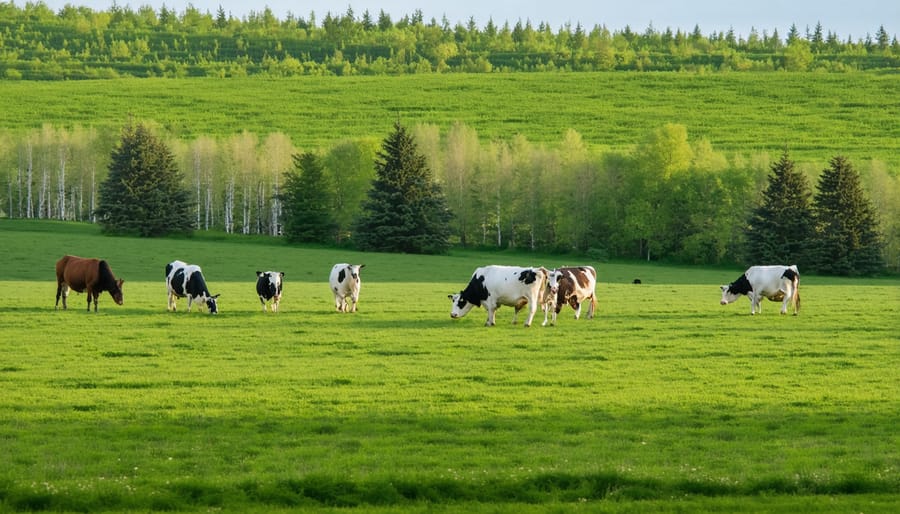
Prairie Silvopasture: Livestock and Timber Economics
While tropical agroforestry might seem worlds away from Canadian prairie operations, the economic principles translate remarkably well to our climate. Consider the silvopasture system at a south-central Manitoba operation, where combining livestock with intentional tree planting has transformed both profitability and resilience.
The operator integrated hybrid poplar rows with cattle grazing on 60 hectares, creating multiple revenue streams that buffer against market volatility. The cattle operation continues generating steady income, while the timber provides a long-term investment maturing over 15-20 years. This diversification reduces financial risk significantly compared to conventional single-enterprise farms.
The economic benefits extend beyond just adding timber sales. Cattle performance improved measurably after tree establishment, with weight gains increasing by approximately 8-12 percent during hot summer months. The livestock naturally seek shade during heat stress periods, reducing energy expenditure and improving feed conversion ratios. Winter windbreaks created by tree rows decreased supplemental feed requirements by an estimated 10-15 percent by moderating cold stress.
Labor efficiency also improved. The trees require minimal management after establishment, while grazing animals naturally control understory vegetation. This reduces mechanical mowing costs and creates a largely self-maintaining system.
The operator reports that timber revenues, while requiring patience, provide substantial returns. Hybrid poplars grown on a 15-year rotation generate approximately 3,500-4,000 dollars per hectare at harvest, with minimal annual input costs. Combined with continuous livestock income, the total economic output per hectare significantly exceeds conventional pasture systems.
This Canadian example demonstrates that agroforestry economics work regardless of climate. The key lies in selecting appropriate species and designing systems that complement existing operations rather than replacing them entirely.
Adapting Tropical Strategies to Short Growing Seasons
Species Selection for Cold Hardiness and Economic Value
While tropical agroforestry systems can’t be replicated exactly in Alberta’s climate, several cold-hardy species deliver comparable economic benefits. The key is matching functional roles rather than copying species lists.
For nitrogen fixation and soil improvement, consider Siberian peashrub, which tolerates temperatures to -45°C and provides livestock fodder. Sea buckthorn offers another nitrogen-fixing option while producing valuable berries for processing into juices and cosmetic products. Both species require minimal inputs once established, reducing operational costs significantly.
Hardy nut trees provide long-term revenue streams similar to tropical tree crops. Black walnut, heartnut, and hybrid hazelnuts have proven successful in Alberta’s chinook belt and milder microclimates. These perennials generate income for decades with lower annual labour requirements than traditional crops.
For understory production, saskatoons, haskap berries, and aronia create value-added opportunities through direct sales and processing. Edmonton-area farmer Mark Johnson reports his haskap operation generates three times the revenue per acre compared to conventional wheat, with growing demand from processors.
Hybrid poplar and willow systems offer biomass production for heating or animal bedding while creating windbreaks that reduce crop moisture loss by up to 20 percent in adjacent fields.
Start small with trial plantings to identify which species thrive in your specific conditions. Provincial nurseries stock cold-hardy varieties, and several agricultural financing programs now support perennial diversification projects, recognizing their contribution to farm economic resilience.
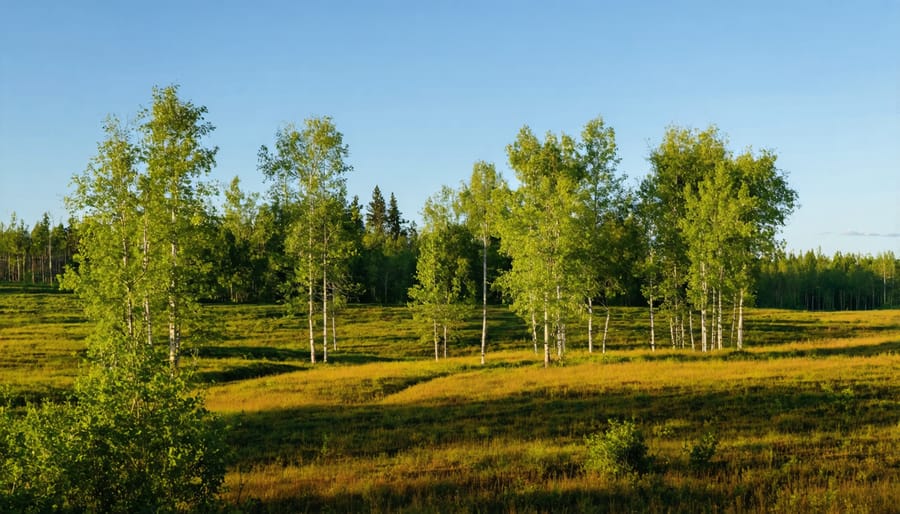
Timing and Management Adjustments
Adapting tropical agroforestry principles to shorter Canadian growing seasons requires thoughtful timing adjustments and flexible management strategies. While tropical systems benefit from year-round growth, Alberta farmers can achieve similar economic resilience through strategic modifications that maximize our compressed timeframe.
Start by adjusting planting schedules to prioritize hardy perennials that establish quickly in spring. In southern Alberta, for instance, haskap berries and saskatoons can be planted as soon as soil temperatures reach 5°C, typically late April. These cold-hardy species fill the perennial crop niche that tropical systems achieve with coffee or cacao, providing reliable income streams once established.
Pruning practices need modification too. Rather than the continuous light pruning common in tropical systems, concentrate maintenance pruning in late winter or early spring before bud break. This approach minimizes stress during our active growing period while maintaining the tree structure essential for multi-layer productivity. A producer near Red Deer shared that scheduling pruning between February and March allows wounds to heal before insects become active, reducing disease pressure significantly.
Intercropping timing becomes crucial when working with a 120-day growing season versus tropical’s 365-day advantage. Plant nitrogen-fixing legumes like field peas alongside tree rows immediately after last frost, allowing them to fix nitrogen during peak growth months. Harvest these support crops before canopy closure reduces light availability, typically by mid-July in most Alberta regions.
Consider succession planting of understory crops in two-week intervals from May through early July, extending harvest windows and maintaining cash flow throughout summer, mimicking the continuous production advantages tropical farmers naturally enjoy.
Getting Started Without Breaking the Bank
Canadian Funding and Support Programs
Canadian farmers exploring agroforestry have access to several funding streams that can offset implementation costs and reduce financial risk. Agriculture and Agri-Food Canada offers support through the Agricultural Climate Solutions program, which funds projects demonstrating climate-smart practices, including tree integration on farmland. The Canadian Agricultural Partnership provides cost-share funding at both federal and provincial levels for activities like soil conservation and diversification projects that align with agroforestry principles.
In Alberta specifically, the Environmental Stewardship and Climate Change program administered through Results Driven Agriculture Research offers grants for beneficial management practices. This can cover expenses like shelter belt establishment, riparian restoration, and silvopasture development—all components of adapted agroforestry systems suitable for prairie conditions.
Farm Credit Canada also provides financing options specifically designed for long-term agricultural improvements, recognizing that tree-based systems require patient capital. Their advisors understand the delayed returns inherent in agroforestry and can structure loans accordingly.
Beyond direct funding, many regions offer technical support through organizations like the Agroforestry and Woodlot Extension Society, which provides free consultations helping farmers design systems appropriate for Canadian climates. These programs recognize that economic resilience starts with reducing barriers to adoption, making diversified farming systems accessible to operations of various sizes.
Start Small: Pilot Projects That Pay Off
You don’t need to overhaul your entire operation to test agroforestry principles. Start with a modest pilot project on a small section of your property, perhaps 0.4 to 2 hectares, where you can observe results without significant risk to your primary income streams.
Consider establishing a windbreak system using fast-growing hybrid poplars or willows along field edges. These trees mature within 5 to 7 years and provide measurable benefits like reduced wind erosion and snow redistribution while you evaluate their impact on adjacent crops. Track your yields in protected versus exposed areas to quantify the economic benefit before expanding.
Another accessible entry point is integrating berry bushes like saskatoons or sea buckthorn into existing pasture systems. Saskatchewan producer Janet Williamson started with just 50 sea buckthorn plants on a quarter-acre trial plot in 2018. Within three years, she generated $2,800 annually from direct sales at farmers’ markets while her cattle continued grazing between rows. The diversified income stream provided a buffer during challenging grain years.
For those with existing shelterbelts, consider underplanting with shade-tolerant crops like ramps or medicinal herbs such as ginseng. This layered approach mirrors tropical agroforestry’s vertical diversity without requiring new land allocation.
Document everything during your pilot phase: input costs, labour hours, yields, and market prices. This data becomes invaluable when deciding whether to scale up and provides concrete evidence when seeking funding or partnerships. Many agricultural extension services offer free guidance for monitoring these trial systems, helping you make informed decisions based on your specific conditions rather than assumptions.
The economic principles underlying tropical agroforestry—diversified income streams, reduced input costs, and enhanced market resilience—translate remarkably well to Canadian agriculture, regardless of your growing zone. While the plant species differ dramatically from tropical systems, the financial logic remains constant: diversity buffers against market volatility, perennial systems reduce annual expenses, and stacked production creates multiple revenue opportunities from the same land base.
Alberta farmers and agricultural professionals across Canada have already demonstrated that adapted agroforestry practices deliver measurable economic benefits. From the haskap and honey operations in Peace Country to the silvopasture systems proving their worth in southern regions, real operations are building financial resilience using these principles. The initial transition requires investment and patience, but the long-term returns—both economic and environmental—justify that commitment.
Your next steps don’t need to be overwhelming. Start by connecting with others on this journey. Reach out to your regional agricultural extension office to learn about agroforestry workshops and demonstration sites in your area. Join farmer networks focused on diversified systems—these communities provide invaluable practical knowledge that textbooks simply can’t capture. Consider starting small with a pilot project on a portion of your operation, perhaps integrating shelterbelts with productive species or experimenting with silvopasture on marginal land.
The economic landscape for Canadian agriculture continues evolving, with climate variability and market pressures demanding more resilient approaches. Tropical agroforestry offers proven financial strategies that, when thoughtfully adapted, strengthen your operation’s bottom line while building long-term sustainability. The question isn’t whether these principles work in Canada—our pioneering farmers have already answered that. The question is when you’ll take your first step toward greater economic resilience.

